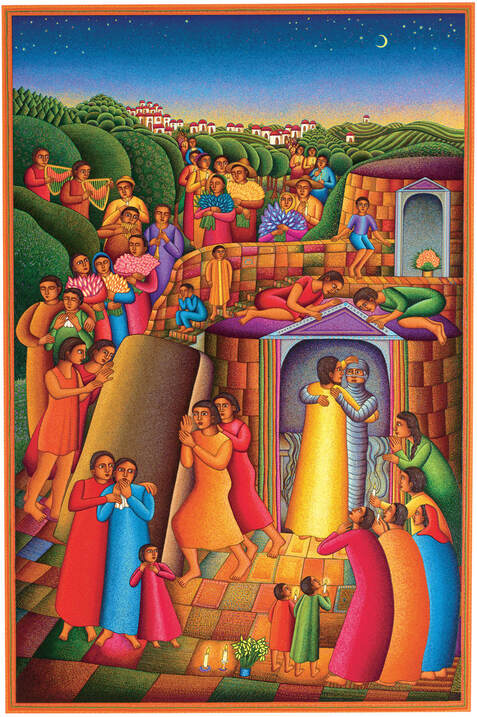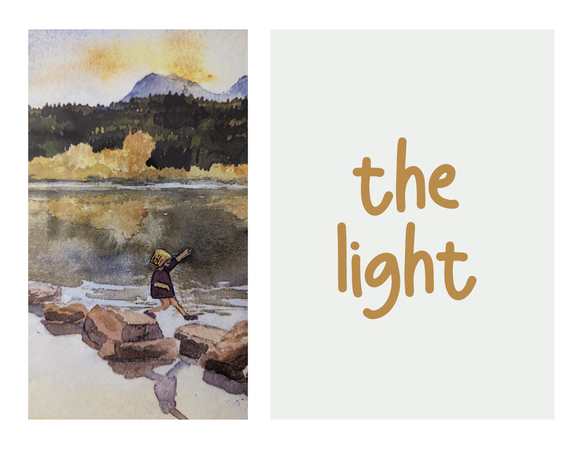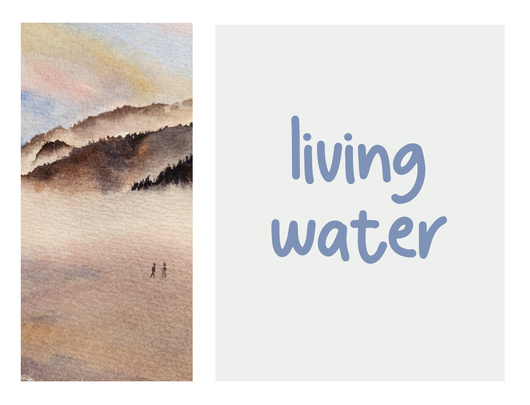 Friends, I am still wrestling with these readings. Dry bones being called to new life. Yikes, I could use some of that new life, especially when feeling dry. And one of the most famous stories in the New Testament: Lazarus is raised from the dead, which is also a family story, and a Christological story. AND invites some re-looking at Lazarus' family. The Gospel of John has its own take on this family, and how it fits in with the rest of the Gospel. It is almost too much. Yet, it may be just what we are ready to hear today. There is Good News all around. Come taste and see. Readings: Ezekiel 37:1-14 † Psalm 130 † Romans 8:6-11 † John 11:1-45 About the Art: Swanson, John August. Take Away the Stone, from Art in the Christian Tradition, a project of the Vanderbilt Divinity Library, Nashville, TN. https://diglib.library.vanderbilt.edu/act-imagelink.pl?RC=58578 [retrieved March 22, 2023]. Original source: Estate of John August Swanson, https://www.johnaugustswanson.com/.
0 Comments
 It’s all about the questions. The pharisees are asking the wrong ones. Most of the characters in the story of this man born blind but now seeing are doing the same. Not “who sinned?” but “How is God present in this life?” Not “How did it happen?” but “What is life like for someone seeing for the first time?” Tell me…so that I may see too. “How is the question that demands an explanation,” writes John Wurster. But this kind of explanation cannot be explained. There’s just too much mystery here. Too much grace. Too much love and mercy to try to describe it adequately. The question that matters is not who did this, or how, or when, but what happens when you begin to see? The thing is there are all sorts of forces that resist this kind of seeing. We might be tempted to ask the why of this one, but it may be more productive to interrogate what this resistance looks like. It sows fear, of course: “We know the law. We know that God has spoken to Moses…but we do not recognize God in this.” Power employs intimidation, either/or thinking, the idea that there is one right way to preserve a way of being that, frankly, does little help people thrive. But here, according to John, God is working on the sabbath, counter to Genesis 2, as Jesus heals this man with adamah¸ with earthly dust (to dust…) mixed with water, with mud simply rubbed on his eyes. How? Who knows? Tell me how the Spirit of God hovers over these living waters, if you can. But She does, creating life in abundance. Imagine the nerve of a God who would violate his own rules! Imagine a God who would be about life—your life, our life, all life—above rules and systems. I mean it. Imagine it, if you can. It just may mean our salvation. Can you see it? Can you perceive it? Enter into worship. Readings: 1 Samuel 16:1-13 † Psalm 23 † Ephesians 5:8-14 † John 9:1-41 About the Art: Painting (detail) by Joyce Walker. Card design by Barbara Anderson. This is an image of a series of cards produced for Lent, 2023, this theme based on resources from Jill Jones.
 For [God’s] is the sea, for she made it, and the dry land, which her hands have crafted. ~Psalm 95:5[i] Water. You can’t live without it; sometimes you can’t live with it. Lake Tahoe is buried under the frozen stuff currently creating all sorts of havoc, while much of the west is drowning in a self-made water shortage that a deepening drought will only make more devastating. It seems in these days in the Anthropocene you either need a canteen or a life raft. You need water from a rock, or you need to strike a path through the depths (that will also cover a pursuing army). Water is a big deal in our religious imagery because it has always been a big deal in human survival and well-being. So floods become symbols of judgment and promise, sometimes troubling ones. Is the wholesale elimination of the unrighteous in Noah’s story really that much better than the Mesopotamian tale of a genocidal flood because the people were just too noisy (and irritating)? The depths hold vast mysteries and their lurking monsters. Wells become places of meeting. Hagar and her son meet God. Rachel and Rebekah and Zipporah meet their matches. So what’s up with this meeting between Jesus and the Samaritan? We may not really know, despite all of our ideas about it. But that’s always the case, we might argue, with a living God and living water. And that is reason enough to hope. Indeed, “Is the Lord among us or not?” is always a live question—or at least the how of it is for a Spirit who moves over the waters effortlessly, like a breath. Enter into worship. Readings: Exodus 17:1-7 † Psalm 95 † Romans 5:1-11 † John 4:5-42 About the Art: Painting (detail) by Joyce Walker. Card design by Barbara Anderson. This is an image of a series of cards produced for Lent, 2023, this theme based on resources written by Jill Jones. [i] Gafney, Wilda C.. A Women's Lectionary for the Whole Church (p. 138). Church Publishing Incorporated. Kindle Edition.
 For what does the scripture say? “Abram believed God, and it was reckoned to him as righteousness.” ~Romans 4:3 Boldly. Abraham went. He went from his country and his father’s house to the land God showed to him. He went to be a blessing. He went for a future. (Genesis 12). He went boldly. And he was praised for it. But. What are we to say? If he was justified by his works—even his “work” of trust—he has nothing to boast about, for even this, Romans and our Reformed tradition argues, is a gift from God. “The wind blows where it will,” Jesus told Nicodemus. And that’s not the whole story anyway, is it? Where are the women? Where are the others? Abraham was not alone when he made his uncertain journey toward promise. What else, who else are we missing here? And what should we make of it? Boldly. And so we too move forward with the promise of faith, hope, and trust. Gifts from God all in our own uncertain time, like Abraham and Sarah, like Nicodemus and the woman at the well and the “we” who know flesh and who know Spirit. Enter into worship. Readings: Genesis 12:1-4a † Psalm 121 † Romans 4:1-5, 13-17 † John 3:1-17 or Matthew 17:1-9 About the Art: Photo (detail) by Scott Anderson. Card design by Barbara Anderson. This is an image of a series of cards produced for Lent, 2023 based on resources from Sarah Are and sanctifiedart.org. Used by permission.
|
worshipYou'll find here links to weekly worship and, where applicable archived service videos. Archives
July 2024
Categories |
 RSS Feed
RSS Feed